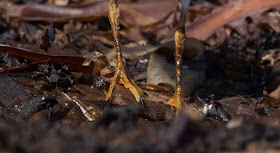On September 12 I went to Chance Cove Provincial Park (southeast Avalon Peninsula) for general birding and possible shorebird photography. I'd heard there were good numbers of shorebirds present there a couple of days earlier. When I arrived there was a good swarm of 300 shorebirds frantically feeding in a bed of fermenting kelp above the daily reach of high tide. Most of the birds were Sanderlings with moderate numbers of Semipalmated Sandpipers & Semipalmated Plovers plus various odds and ends. The mid morning sun was already high and perfectly back lighting the shorebirds with an added powerful of glare reflecting off the water. An impossible situation unless I got behind the birds on the waters edge. There were so many birds present I decided to give it a shot. Water was washing around my feet as I set up the tripod and got the big lens ready. I was hurrying a little because naked eye I noticed a robust looking juvenile Semipalmated Plover emitting a host of alarming vibes. It was the first bird I put the camera on. Whoa! This looks good. Then tried binoculars. Then returned to the camera aimed at nothing but this bird for the next 30-40 minutes.
It looked big, strong, long back, more oblong shaped head The broad dark band through the lores covered the gape and a little below. This was a juvenile COMMON RINGED PLOVER. (CRPL) The juvenile Semipalmated Plovers (SEPL) in comparison were like little wind up toys with cute little rounded heads, like teenage plovers not fully developed physically .
The bird was defending a feeding area close to where I was set up. In the end it vanished. I think the less confrontational Semipalmated Plovers won out on patience by standing their ground. In the end. several SEPL fed in the area that the CRPL wanted for itself.
The webbing in the toes is a defining field mark but not crucial for identification. Between middle toe an inner toe CRPL has no webbing, SEPL have a small amount of webbing. Between middle toe and outer toe CRPL have a very rudimentary tiny webbing, SEPL has a large area of webbing. Tons of caution should be used even in photos when judging the presence or lack of webbing. SEPL with slightly relaxed toes can lose the appearance of webbing as the loose web aligns with the toes. Photos of the same SEPL seconds apart can looked fully webbed to unwebbed.
Above are two images of the CPRL toes. And below is one image of a SEPL toes fully out stretched and clearly visible even when partially covered with beach debris










No comments:
Post a Comment
Note: only a member of this blog may post a comment.